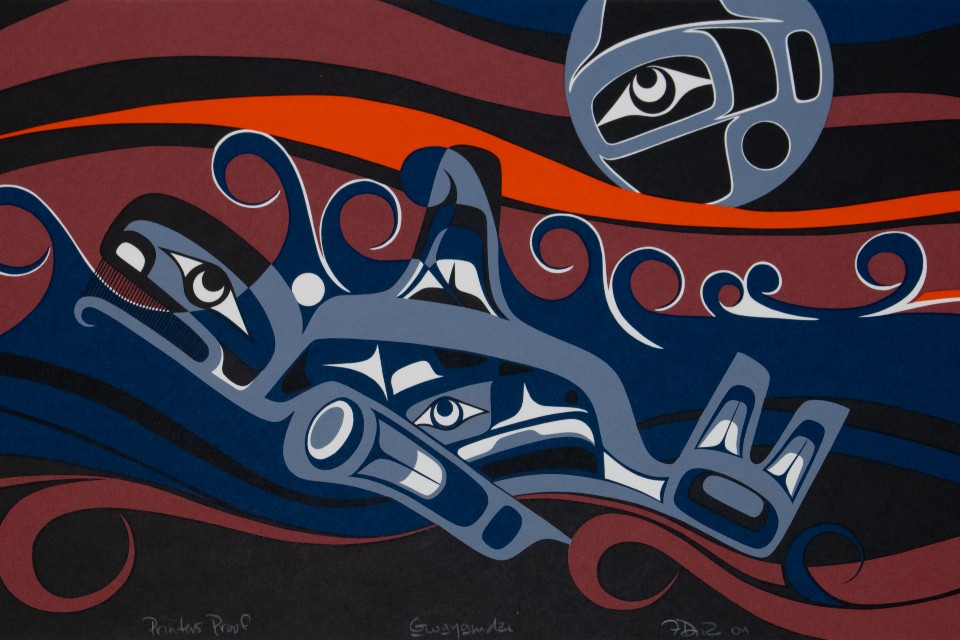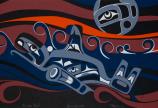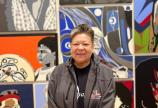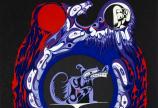Alumna Francis Dick transforms darkness into light in new exhibition
- Stephanie Harrington

Francis Dick invites you to walk through her fires. The multimedia artist’s new solo exhibition at Legacy Art Gallery is an autobiography told through art, each image and object testament to her life’s journey, her culture, her fearlessness, and her ability to transform joy and pain into art.
From the moment you step into the exhibition, you are immersed in Dick’s world, beginning with silkscreen prints exploring her experience as a Musǥa̱'makw Dzawada̱'enux̱w woman from Kingcome Inlet, where she was born in 1959. The exhibition includes carvings and jewelry created by Dick, a series of brightly painted handcrafted guitars, and a wall of striking portraits that Dick has painted of people in her life.
Co-curated with Lorilee Wastasecoot, the gallery’s curator of Indigenous art and engagement, Walking Thru My Fires explores Indian Residential School legacies, urban Indigeneity, reconciliation and the healing power of art.
“Every piece I have here is a story about something I’ve been impacted by, whether it’s been really positive or heavy,” says Dick, who is a member of the Kwakwaka'wakw Nation. “This exhibition is about my journey through life, sharing my inspiration, sharing my darkness and transforming darkness into light.”
Transformation through art
Dick’s career as an artist parallels her inner journey. She turned to art after graduating from UVic with a bachelor’s degree in social work. After moving to Victoria as a young adult, Dick returned to Kingcome Inlet, about 300 km northwest of Vancouver, to work in her field. But after a year, the job proved overwhelming.
Looking for a way to express herself, Dick began to paint. Her first work, Kawadelekala, a tribute to her late grandmother, tells the story of the Dzawada’enuxw creation legend and her family’s connection as direct descendants of the Kawadelekala (wolf) family.
“I just fell into it, it just happened naturally for me,” she says while standing in front of the artwork. “I didn’t see myself as an artist. I don’t see myself as an artist.”
In 1985, four months after selling her first series of prints, Dick’s brother died by suicide. Her second print, Kałaliłam, is a tribute to Jesse, who remains a great inspiration in her work, and is often portrayed as an eagle in her art.
“He used to speak of flying away. This eagle is how I envisioned him transitioning from this life to another, powerful and free,” she says.
Rage and healing
Dick returned to Victoria and kept creating. She began to explore her rage, about the abuse and tragedy she endured as a young child and the genocide inflicted upon Indigenous Peoples. Dick’s mother died when Dick was six, shortly after she returned home from residential school. After that, she was fostered out to live with extended family. Making art is one of the ways she deals with the abuse and loneliness she suffered during her childhood.
Dick stands in front of Walking Thru My Fires, the work after which the exhibition is named. The print depicts Dick as a wolf, teeth bared, sitting on a beam of light. The wolf’s body is encompassed by a phoenix, the outer edges of the work are black.
“I thought years ago, if I were ever to write a book, an autobiography, I’d call it Walking Through my Fires; it’s really appropriate,” she says.
The print represents Dick taking back her power, starting a long and ongoing process of healing.
“I really got in touch with my rage about my history, the abuse I went through as a child, even before I went to residential school. I recognized there were so many different intensities to my anger, hot anger, cold anger, murderous rage anger,” she says. “Because I was in so much darkness, I had to believe there was light somewhere, within or without.”
Dick continues to reckon with history in other parts of the exhibition. Six painted desks, each illuminated with light, are arranged in a circle in a separate room. A tribute to the 150,000 Indigenous children sent to residential schools in Canada, thousands of whom didn’t return home, it’s a new project for Dick, and a powerful one that she plans to expand upon. Under the mezzanine in the gallery, Dick will be painting a seventh desk and working on other art over the exhibition.
Capturing joy
Although Dick doesn’t shy away from darkness, there is great joy and celebration in her work too. In person, she laughs often and is open and frank about her life. She points proudly to a series of portraits, some of her most recent work, which raise up the people in her life she has connected with, including Elders and students from her home community where she taught language, dance and art, as well as local blues musicians and friends in Victoria. A black and white portrait of Jesse hangs on the wall in front of us, and he gazes out with a gentle smile, stylish, handsome and poised.
“My hope was to capture the essence of some of these people with my work,” she says. “I love these portraits.”
While she borrows elements from northwest coast design, her art isn’t traditional. Dick, in her art and in her life, has made her own rules—fearlessly and with no apologies. She has travelled the world with her art but she says the most important journey is within each of us.
“This exhibition is for everybody who is working on their inner journey,” Dick says, “the most incredible journey anyone will ever take and the hardest and the most beautiful one.”
Walking Thru My Fires runs at Legacy Art Gallery until Sept. 9. The exhibition’s opening event is Saturday, April 29, from 5 pm to 7 pm. Visit Legacy Art Galleries for details.



